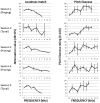Agreement and reliability of tinnitus loudness matching and pitch likeness rating
- PMID: 25478690
- PMCID: PMC4257689
- DOI: 10.1371/journal.pone.0114553
Agreement and reliability of tinnitus loudness matching and pitch likeness rating
Abstract
The ability to reproducibly match tinnitus loudness and pitch is important to research and clinical management. Here we examine agreement and reliability of tinnitus loudness matching and pitch likeness ratings when using a computer-based method to measure the tinnitus spectrum and estimate a dominant tinnitus pitch, using tonal or narrowband sounds. Group level data indicated a significant effect of time between test session 1 and 2 for loudness matching, likely procedural or perceptual learning, which needs to be accounted in study design. Pitch likeness rating across multiple frequencies appeared inherently more variable and with no systematic effect of time. Dominant pitch estimates reached a level of clinical acceptability when sessions were spaced two weeks apart. However when dominant tinnitus pitch assessments were separated by three months, acceptable agreement was achieved only for group mean data, not for individual estimates. This has implications for prescription of some sound-based interventions that rely on accurate measures of individual dominant tinnitus pitch.
Conflict of interest statement
Figures



Similar articles
-
Individual Reliability of the Standard Clinical Method vs Patient-Centered Tinnitus Likeness Rating for Assessment of Tinnitus Pitch and Loudness Matching.JAMA Otolaryngol Head Neck Surg. 2018 Dec 1;144(12):1136-1144. doi: 10.1001/jamaoto.2018.2416. JAMA Otolaryngol Head Neck Surg. 2018. PMID: 30267085 Free PMC article.
-
Psychoacoustic assessment to improve tinnitus diagnosis.PLoS One. 2013 Dec 12;8(12):e82995. doi: 10.1371/journal.pone.0082995. eCollection 2013. PLoS One. 2013. PMID: 24349414 Free PMC article. Clinical Trial.
-
Evaluation of iPod-Based Automated Tinnitus Pitch Matching.J Am Acad Audiol. 2015 Feb;26(2):205-12. doi: 10.3766/jaaa.26.2.9. J Am Acad Audiol. 2015. PMID: 25690779
-
A Pilot Study to Evaluate a Residual Inhibition Technique in Hearing Aids for Suppression of Tinnitus.Semin Hear. 2023 Jun 28;45(1):123-140. doi: 10.1055/s-0043-1770153. eCollection 2024 Feb. Semin Hear. 2023. PMID: 38370522 Free PMC article. Review.
-
Auditory sensori-neural alterations induced by salicylate.Prog Neurobiol. 2000 Dec;62(6):583-631. doi: 10.1016/s0301-0082(00)00027-7. Prog Neurobiol. 2000. PMID: 10880852 Review.
Cited by
-
Tinnitus in Children.J Assoc Res Otolaryngol. 2024 Jun;25(3):239-247. doi: 10.1007/s10162-024-00944-3. Epub 2024 May 6. J Assoc Res Otolaryngol. 2024. PMID: 38709437 Free PMC article. Review.
-
Vagus Nerve Stimulation Paired with Tones for the Treatment of Tinnitus: A Prospective Randomized Double-blind Controlled Pilot Study in Humans.Sci Rep. 2017 Sep 20;7(1):11960. doi: 10.1038/s41598-017-12178-w. Sci Rep. 2017. PMID: 28931943 Free PMC article. Clinical Trial.
-
Psychometric properties of the Tinnitus Functional Index (TFI): Assessment in a UK research volunteer population.Hear Res. 2016 May;335:220-235. doi: 10.1016/j.heares.2015.09.009. Epub 2015 Sep 28. Hear Res. 2016. PMID: 26415998 Free PMC article.
-
The effect of caffeine on tinnitus: Randomized triple-blind placebo-controlled clinical trial.PLoS One. 2021 Sep 20;16(9):e0256275. doi: 10.1371/journal.pone.0256275. eCollection 2021. PLoS One. 2021. PMID: 34543285 Free PMC article. Clinical Trial.
-
Comparing Three Established Methods for Tinnitus Pitch Matching With Respect to Reliability, Matching Duration, and Subjective Satisfaction.Trends Hear. 2019 Jan-Dec;23:2331216519887247. doi: 10.1177/2331216519887247. Trends Hear. 2019. PMID: 31805822 Free PMC article.
References
-
- Henry JA, Zaugg TL, Schechter MA (2005) Clinical guide for audiologic tinnitus management 1: Assessment. Am J Audiol 14:21–48. - PubMed
-
- Tass PA, Adamchic I, Freund H-J, von Stackelberg T, Hauptmann C (2012) Counteracting tinnitus by acoustic coordinated reset neuromodulation. Rest Neurol Neurosci 30:137–159. - PubMed
-
- Terwee CB, Bot SDM, de Boer MR, van der Windt DAWM, Knol DL, et al. (2007) Quality criteria were proposed for measurement properties of health status questionnaires. J Clin Epidemiol 60:34–42. - PubMed
Publication types
MeSH terms
LinkOut - more resources
Full Text Sources
Other Literature Sources
Medical

